World 🢖 Asia 🢖 Bangladesh
Ancient cities and towns 🢔 Settlements 🢔 Archaeological wonders 🢔 Categories of wonders
Wonder
Mahasthangarh
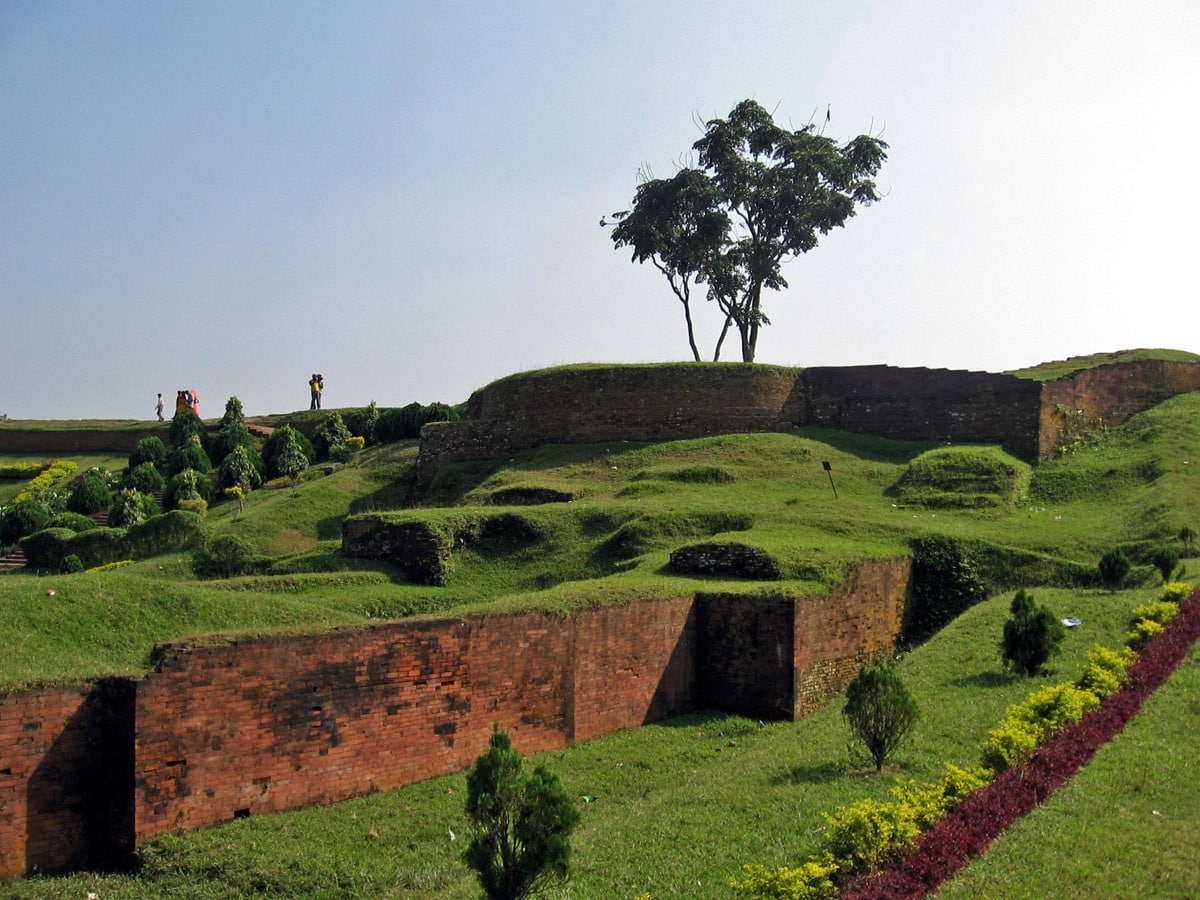
 In short
In short
True wonder of the ancient past of Bangladesh is Mahasthangarh. This enormous city was founded at 300 BC or even earlier and served as a capital of Pundravardhana state.
 45.8%
45.8%
GPS coordinates
Location, address
Name in Bengali
Alternate names
Founded
Flourished
Abandoned
Map of the site
If you see this after your page is loaded completely, leafletJS files are missing.
 In detail
In detail
Location
Mahasthangarh is located next to Karatoya River, in a comparatively high location, some 25 m above sea level. Currently, this is a small, silted river but in the earlier times, Karatoya was an important and sacred river, which then seemed to be as large as the sea: reportedly three times wider than Ganges in the 13th century AD. This river served as a border between Pundravardhana and Kamarupa – another ancient country to the east.
This high bank at the giant river was one of the main reasons why this location was selected for the city. And the most likely loss of the might of this river can be blamed for the decline of the city. Such changes in the flow of rivers are frequent in Bangladesh and are caused by silting and earthquakes.
Rivers were the main transport routes but Mahasthangarh was connected to important regional centers (e.g. Pataliputra, Mithila) with roads as well.
Description
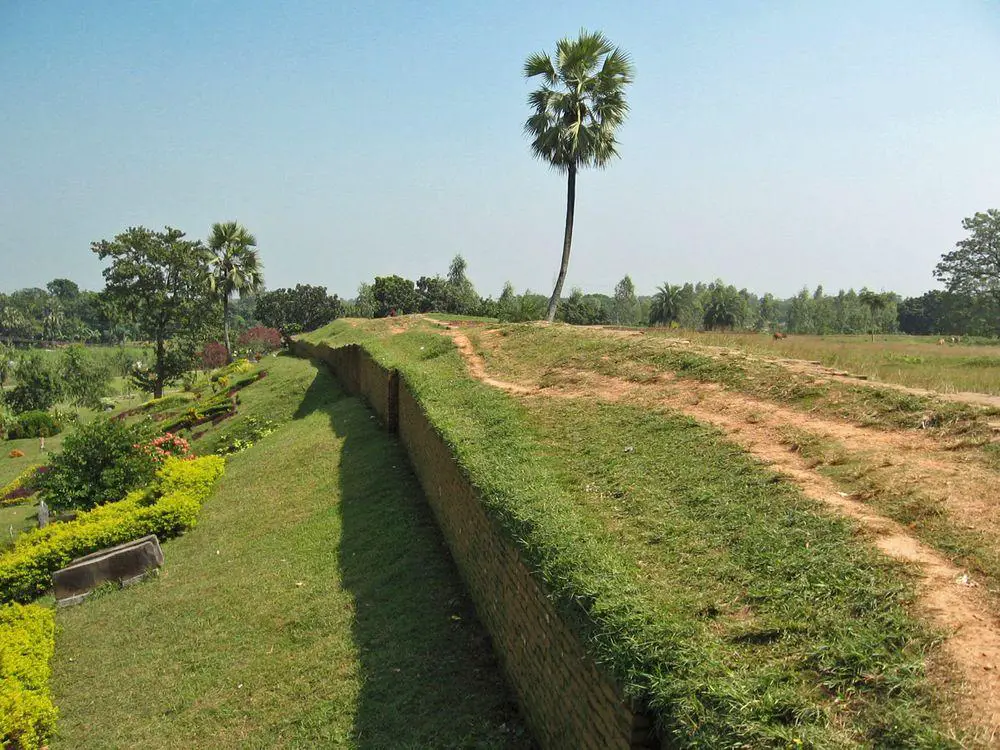
Remnants of this ancient city are well visible up to this day albeit not too exciting: for most part there are visible massive ramparts and simple brick walls of diverse buildings.
Main part of this city is its citadel – fortified central part of the city. This rectangular area is 1,523 km long from north to the south and 1,371 m wide in east – west direction, enclosing an area of 185 ha. The impressive brick ramparts around the citadel have been preserved up to this day and rise up to 11 – 13 m high above the surroundings. Around the walls was made also a ditch which also partly has been preserved.
Structures inside the citadel
Citadel has several gateways – Kata Duar in the north, Dorab Shah Toran in the east, Burir Fatak in the south and Tamra Dawaza in the west.
There are remnants of many interesting buildings inside the citadel. Some of these structures are:
- Bairagir Bhita – palace for women – hermits, built in the 4th – 5th century AD.
- Jiat Kunda – well which, according to legends, possessed life giving power. According to legends dead soldiers were revived with its water during the fights.
- Khodar Pathar Bhita – Buddhist shrine.
- Munir Ghon – impressive bastion.
- Parasuramer Basgriha – palace of king Parasuram, in use from 800 AD to 1800 AD.
Structures outside the citadel
Hundreds of mounds scattered for kilometres to the north, west and south from the citadel testify that Mahasthangarh was a true metropolis also by today’s scale. Each of these mounds hides some important ancient structure or group of structures. Most of these mounds are unexplored up to this day, but some of the most interesting explored sites are:
- Govinda Bhita – temple of Govinda is located to the north-east from the city walls, at Karatoya river. This is ancient building, possibly from the 3rd century AD, although here have been found artefacts from the 3rd century BC.
- Mazar – holy tomb of Shah Sultan Balkhi Mahisawar with later built mosque next to it. This structure is located at the south-eastern corner of citadel, in the site of an ancient Hindu temple.
- Gokul Medh is located some 3 km south from the citadel. This Buddhist monastery belongs to most impressive archaeological sites in this area. This enormous structure was excavated in 1934 – 1936, when 172 rectangular blind cells were exposed. Gokul Medh was built in the 6th – 7th century AD. On the top of this approximately 13 m tall structure was standing stupa which is lost now.
History
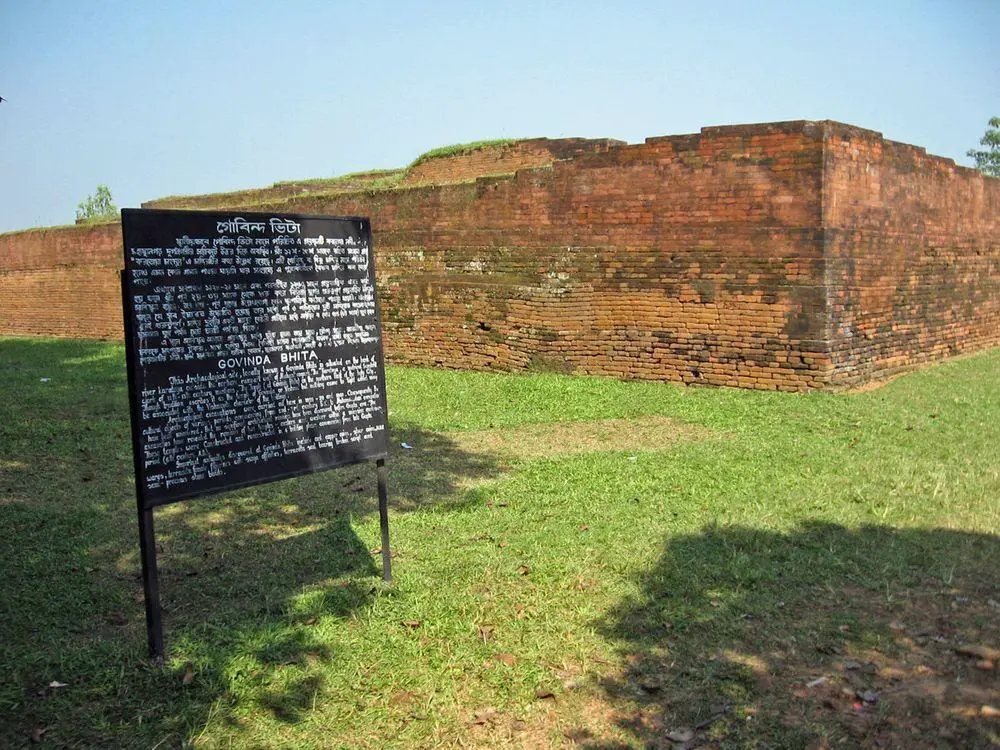
Mahasthangarh is one of the oldest ancient cities discovered so far in Bangladesh. Its true age is unknown, but the oldest dated artifact here is an inscription from the 3rd century BC. It is written in Prakrit – Indo-Aryan language.
City though could be much older, even from the 7th century BC.
Its current name – Mahasthangarh – comes from the medieval times and in Sanskrit means a place of sanctity (Mahasthan) and fort (garh).
Capital of Pundravardhana
Mahasthangarh is the former capital of Pundravardhana – the state of the Pundra people. This was an ancient state, founded by a little-known culture that spoke in a language which does not belong to the Indo-European family.
Initially Hinduism was the main religion here but it is assumed that Buddhism came here already before the 3rd century BC. This new religion did not come without conflict – thus some 18,000 followers of Ajivika philosophy were killed upon the orders of Mauryan Emperor Ashoka in the area of Pundravardhana.
Mahasthangarh developed as an important inland port with an intense connection to the seaport of Chittagong.
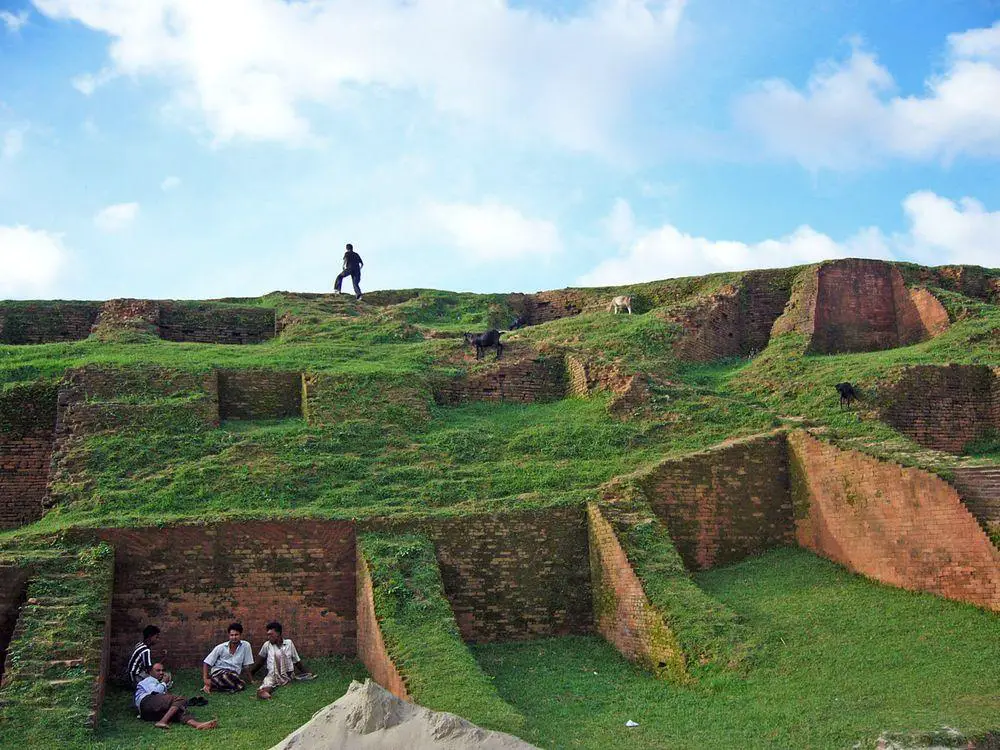
Medieval times
In the 6th century Pundravardhana most likely became a part of the Gauda empire and did not exist as a separate political unit anymore.
Importance of Mahasthangarh decreased together with the decline of Pundravardhana, although the city was enormous and continued to be inhabited for centuries long. In the 8th – 12th centuries it was an important center of Buddhist religion as testified by numerous large monasteries built in this time here.
Local people were converted to Islam in the 14th century AD by Shah Sultan Balkhi Mahisawar, who resided in Mahasthangarh after he took it with force from Raja Parshuram in 1343. His tomb (mazar) is located in the ancient city.
New times
Fortifications of Mahasthangarh were used until the 18th century (and even during the liberation war in 1971) but it was never fully abandoned – Bangladesh is too densely populated to afford such a luxury.
First European to visit this ancient city was explorer Francis Buchanan Hamilton in 1808. Another explorer – Alexander Cunningham identified this ancient site as the capital of Pundravardhana in 1879.
In 1928 there were started excavations by Kashinath Narayan Dikshit, Archaeological Survey of India. Soon after the inside of the citadel was cleaned – before the excavations it looked rather like a hill. Excavations continue up to this day and we can be sure that scientists will have here enough work for centuries. Researchers have identified in the cultural layer of this ancient city 18 construction layers from different periods.
Mahasthangarh does not belong to the most spectacular landmarks but nevertheless, it is popular among people interested in history. It is also a sacred place for Hindus. Next to the site is built a museum which contains many items which have been found during the excavations.
Unfortunately Mahasthangarh is endangered – an unknown quantity of artifacts are stolen from the hundreds of unexplored mounds, the site is also endangered by swamping.
References
- A. K. M. Yaqub Ali. Pundranagara: an Emporium of North Bengal. Journal of the Asiatic Society of Bangladesh, Vol. 53, No.1., June 2008, Dhaka.
 Linked articles
Linked articles
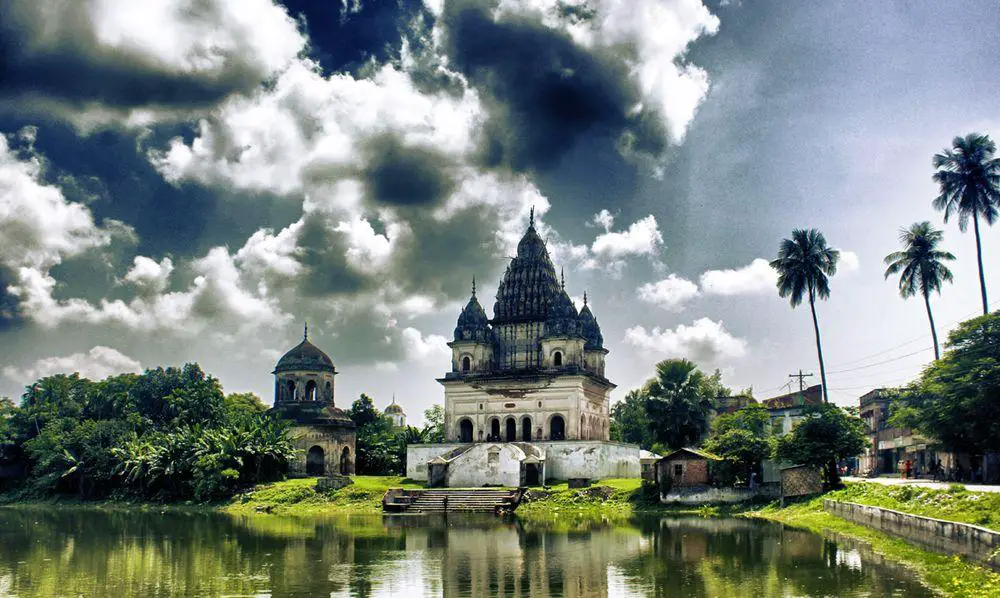
Wonders of Bangladesh
The densely populated Bangladesh has had large and influential cities for millennia long. The country is rich with interesting archaeological heritage, such as remnants of viharas – Buddhist shrines and monasteries and abandoned ancient cities.

Abandoned cities and towns
The main impression created by abandoned cities is intimate. This is a mixed feeling of sadness, unclear anxiety (“my city will not be eternal either”), and at the same time – inspiration from the abilities of our ancestors. Long ago, without electricity, paper, or different mechanisms, they managed to create magnificent structures, that covered many square kilometers.

Ancient cities and towns
It turns out that urban planning is a very old profession. The urban fabric of ancient settlements – their structure and evolution gives a lot of food for thoughts about the nature of humans and civilization.
Wondermondo includes in the category of ancient cities and towns those settlements which have developed as urban areas at least 1500 years ago: around 500 AD.
 Recommended books
Recommended books
A History of Bangladesh
Bangladesh is a new name for an old land whose history is little known to the wider world. A country chiefly famous in the West for media images of poverty, underdevelopment, and natural disasters, Bangladesh did not exist as an independent state until 1971.
Bangladesh (Bradt Travel Guide)
This updated guidebook, with a focus on responsible tourism, offers greater coverage than any other to the Chittagong Hill Tracts, and to the world’s largest mangrove forest at the Sundarbans. Personal insights guide travelers to aspects of the country almost unknown to visitors – dolphin and whale watching, winter bird-watching, and golden Bengal’s silk and archaeological highlights.


